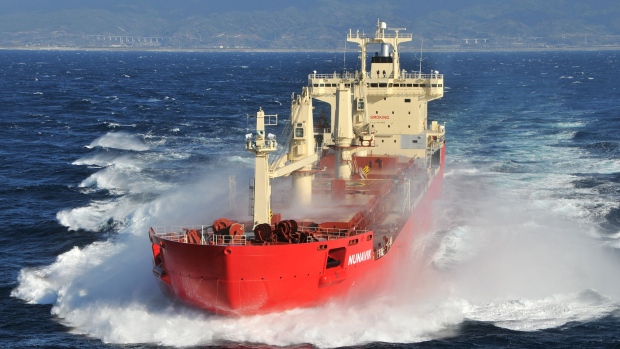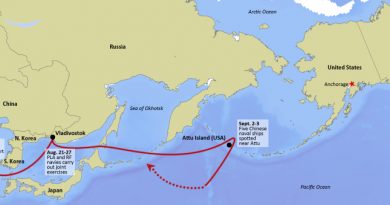Blog: What’s in a name? The Japanese-built, Chinese-chartered icebreaker – MV Nunavik

At the Nunavik Nickel Project mine in northern Quebec, Japanese shipbuilding skills, Chinese mining expertise, and European demand are combining to turn this remote corner of Canada into a site that exemplifies the impact of globalization on the Arctic.
On March 20, Fednav, a Canadian shipowning and chartering company, announced its receipt of the MV Nunavik, a polar-class 4, 25,000 DWT bulk-carrying icebreaker built by the Japanese shipbuilding company Japan Marine United. Fednav claims to be the leader in international shipping on the Great Lakes and in the Canadian Arctic, where it allegedly operates the world’s biggest ice-class bulk carrier fleet. MV Nunavik will transport supplies to Canadian Royalties’ Nunavik Nickel Project mine and ship out the nickel and copper concentrates extracted to northern Europe. As a PC4 vessel, the MV Nunavik will be able to sail without escort through the Arctic, traveling 3 knots through ice 1.5 meters thick. The ship is also the first Canadian-owned vessel to have a ballast treatment system onboard, which will help reduce its environmental impact. Though the ship is Canadian-owned, the mine, in fact, is not. Although Canadian Royalties may sound like a Canadian company, Chinese mining company Jilin Jien Nickel Industry Co. Ltd. acquired it through its Canadian subsidiary, Jien Canada Mining Ltd, in 2010. Although the names of ships, mines, and companies might remain Arctic-inspired, the investments and technology are increasingly coming from non-Arctic countries.
Asian investment and technology in the Arctic
While the Asian countries may only be observers in the Arctic Council, without their organizational and technical abilities, the nickel and copper would likely still be in the ground in Nunavik. In northern Quebec and an increasing number of other areas in the Arctic, Asian companies are enabling the extraction of natural resources. It’s not just their money that is going into the Arctic, but their technology and expertise, too. While the Arctic Council limits the financial contributions that Asian countries can make to Council projects so that they never outstrip funding by a permanent member, fewer such limits exist in the world of commodity chains. The Arctic Council can therefore do little to limit the impact of Asian investment and technology in the Arctic, even despite efforts such as the newly-created Arctic Economic Council [1]. While perhaps a greater amount of wealth or benefits from extraction might be retained within the Arctic, much of that wealth is due to the activities of Asian countries like Japan, China, and also South Korea and Singapore.
Many people in Greenland are concerned about the potential plans of London Mining Corporation to bring in 3,000 Chinese laborers to work in mines slated for construction in the southern part of the country. A labor flow of this size would likely be disruptive to Greenland, whose entire population is only about 55,000. But the less visible flows of chairpersons, capital, and infrastructure from Asia to Arctic countries are just as significant.
What’s in a name?
The Japanese-built ship chartered by the Chinese-owned mining company is called the MV Nunavik for reasons Fednav explained in its press release: “In naming this new ship Nunavik, Fednav wanted to recognize the inhabitants and the region in which it will operate as well as its project partner, Nunavik Nickel.” Nunavik is the Inuit name for northern Quebec. To be fair, it must be acknowledged that indigenous peoples are indeed working on the mine in partnership with Canadian Royalties. Yet given the international forces enabling the extraction of minerals from the Nunavik soil, the ship might as well have been named after something from China, Japan, or northern Europe. Instead, it was named after a Canadian and Inuit place, just as Canadian Royalties maintained its name even under new Chinese ownership. In the Canadian Arctic, where the government places a particularly strong emphasis on northern identity, maintaining local names and symbols is especially important. Yet they often disguise what is in reality a region more globalized than Prime Minister Stephen Harper and current Chair of the Arctic Council Leona Aglukkaq might like to believe.
Paul Pathy, President and Co-CEO of Fednav Limited, expressed, “Fednav is particularly proud of the arrival of this new ship…It represents Fednav’s commitment to mining development in the Arctic, as well as our dedication to technological development and energy efficiency.” What the Canadian businessman did not say, however, is that the ship also represents the intensification of global, and particularly Asian, interest in extracting Arctic resources.
Notes
[1] I find it only slightly ironic that the photograph accompanying the Arctic Council’s press release on the Arctic Economic Council, which comes out of a recognition “that Arctic economic endeavors are integral to sustainable development for peoples and communities in the region,” is accompanied by a photograph that I took which, as I explained when I submitted it, portrays three Lithuanian men at work – not native-born Arctic residents.



